Bushranger

Bushrangers were originally escaped convicts in the early years of the British settlement of Australia who had the survival skills necessary to use the Australian bush as a refuge to hide from the authorities. By the 1820s, the term "bushranger" had evolved to refer to those who abandoned social rights and privileges to take up "robbery under arms" as a way of life, using the bush as their base. Bushranging thrived during the gold rush years of the 1850s and 1860s when the likes of Ben Hall, Frank Gardiner and John Gilbert led notorious gangs in the country districts of New South Wales. These "Wild Colonial Boys", mostly Australian-born sons of convicts, were roughly analogous to British "highwaymen" and outlaws of the American Old West, and their crimes typically included robbing small-town banks and coach services. In other infamous cases, such as that of Dan Morgan, the Clarke brothers, and Australia's best-known bushranger, Ned Kelly, numerous policemen were murdered. The number of bushrangers declined due to better policing and improvements in rail transport and communication technology, such as telegraphy. Kelly's capture and execution in 1880 effectively represented the end of the bushranging era.
Bushranging exerted a powerful influence in Australia, lasting for almost a century and covering much of the continent. Its origins in a convict system bred a unique kind of desperado, frequently with an Irish political background. Native-born bushrangers also expressed nascent Australian nationalist views and are recognised as "the first distinctively Australian characters to gain general recognition."[2] As such, many bushrangers became folk heroes and symbols of rebellion against the authorities. Firmly entrenched in Australian folklore, bushrangers have inspired many works in the arts, including bush ballads, plays and films.
History
Convict era
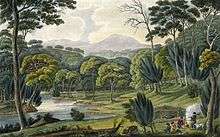
Over 2,000 bushrangers are estimated to have roamed the Australian countryside, beginning with the convict bolters and drawing to a close after Ned Kelly's last stand at Glenrowan.[3]
Bushranging began soon after British colonisation with the establishment of Sydney, New South Wales as a penal colony in 1788. The majority of early bushrangers were convicts who had escaped prison, or from the properties of landowners to whom they had been assigned as servants. These bushrangers, also known as "bolters", preferred the hazards of wild, unexplored bushland surrounding Sydney to the deprivation and brutality of convict life. The first bushranger gang, led by African convict John Caesar, robbed settlers for food, and kept a tempestuous alliance with Aboriginal resistance fighters during Pemulwuy's War. While other bushrangers would go on to fight alongside Indigenous Australians in frontier conflicts with the colonial authorities, the Government tried to bring an end to any such collaboration by rewarding Aborigines for returning convicts to custody. Aboriginal trackers would play a significant role in the hunt for bushrangers.
Colonel Godfrey Mundy described convict bushrangers as "desperate, hopeless, fearless; rendered so, perhaps, by the tyranny of a gaoler, of an overseer, or of a master to whom he has been assigned." Edward Smith Hall, editor of early Sydney newspaper The Monitor, agreed that the convict system was a breeding-ground for bushrangers due to its savagery, with starvation and acts of torture being rampant. "Liberty or Death!" was the cry of convict bushrangers, and in large numbers they roamed beyond Sydney, some hoping to reach China, which was commonly believed to be connected by an overland route. Only a minority of bolters managed to seize boats and escape to foreign lands overseas, and even then they were often hunted down and brought back to Australia. Others attempted to inspire an overhaul of the convict system, or simply sought revenge on their captors. This latter desire found expression in the convict ballad "Jim Jones at Botany Bay", in which Jones, the narrator, plans to join bushranger Jack Donahue and "gun the floggers down". Convict bushrangers were also prevalent in the penal colony of Van Diemen's Land, established in 1803.
1850s: gold rush era
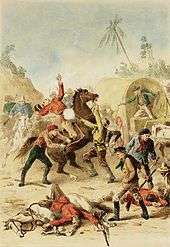
The bushrangers' heyday was the Gold Rush years of the 1850s and 1860s as the discovery of gold gave bushrangers access to great wealth that was portable and easily converted to cash. Their task was assisted by the isolated location of the goldfields and a police force decimated by troopers abandoning their duties to join the gold rush.[3]
George Melville was hanged in front of a large crowd for robbing the McIvor gold escort near Castlemaine in 1853.[3]
1860s
Bushranging numbers flourished in New South Wales with the rise of the colonial-born sons of poor, often ex-convict squatters who were drawn to a more glamorous life than mining or farming.[3]
Much of the activity in this era was in the Lachlan Valley, around Forbes, Yass and Cowra.[3]
Frank Gardiner, John Gilbert and Ben Hall led the most notorious gangs of the period. Other active bushrangers included Dan Morgan, based in the Murray River, and Captain Thunderbolt.[3] Thunderbolt was the most successful Australian bushranger, if bushranging longevity is the benchmark, as he bushranged across northern New South Wales for six-and-a-half years until shot near Uralla in 1870.[4] With his death, the New South Wales bushranging epidemic of the 1860s officially ended.[5]
1870s to 1900s
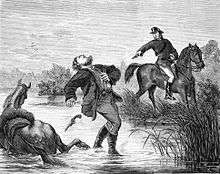
The increasing push of settlement, increased police efficiency, improvements in rail transport and communications technology, such as telegraphy, made it increasingly difficult for bushrangers to evade capture.
Among the last bushrangers was the Kelly Gang led by Ned Kelly, who were captured at Glenrowan in 1880, two years after they were outlawed.
In 1900 the indigenous Governor Brothers terrorised much of northern New South Wales.[3]
Public perception
In Australia, bushrangers often attract public sympathy (cf. the concept of social bandits). In Australian history and iconography bushrangers are held in some esteem in some quarters due to the harshness and anti-Catholicism of the colonial authorities whom they embarrassed, and the romanticism of the lawlessness they represented. Some bushrangers, most notably Ned Kelly in his Jerilderie letter, and in his final raid on Glenrowan, explicitly represented themselves as political rebels. Attitudes to Kelly, by far the most well-known bushranger, exemplify the ambivalent views of Australians regarding bushranging. Victoria's state cricket team adopted 'Bushrangers' as their team nickname in honour of those such as the Kelly Gang, who lived in the Victorian bush.
Legacy
The impact of bushrangers upon the areas in which they roamed is evidenced in the names of many geographical features in Australia, including Kelly Country, Thunderbolts Way, Brady's Lookout, Mount Tennent and Ward's Mistake.
Popular culture
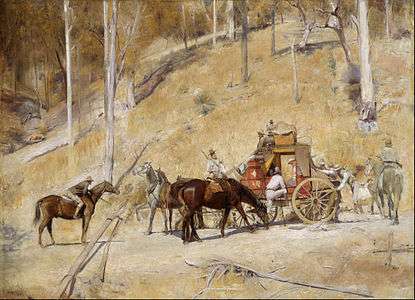

Tom Roberts, one of the leading figures of the Heidelberg School (also known as Australian Impressionism), depicted bushrangers in some of his historical paintings, including In a corner on the Macintyre (1894) and Bailed Up (1895), both set in Inverell, the area where Captain Thunderbolt was once active.
Although not the first Australian film with a bushranging theme, The Story of the Kelly Gang (1906)—the world's first feature-length narrative film—is regarded as having set the template for the genre. On the back of the film's success, its producers released one of two 1907 film adaptations of Boldrewood's Robbery Under Arms (the other being Charles MacMahon's version). Entering the first "golden age" of Australian cinema (1910–12), director John Gavin released two fictionalised accounts of real-life bushrangers: Moonlite (1910) and Thunderbolt (1910). The genre's popularity with audiences led to a spike of production unprecedented in world cinema.[6] Dan Morgan (1911) is notable for portraying its title character as an insane villain rather than a figure of romance. Ben Hall, Frank Gardiner, Captain Starlight, and numerous other bushrangers also received cinematic treatments at this time. Alarmed by what they saw as the glorification of outlawery, state governments imposed a ban on bushranger films in 1912, effectively removing "the entire folklore relating to bushrangers ... from the most popular form of cultural expression."[7] It is seen as a major reason for the collapse of a booming Australian film industry.[8] One of the few Australian films to escape the ban before it was lifted in the 1940s is the 1920 adaptation of Robbery Under Arms.[6] Also during this lull appeared American takes on the bushranger genre, including The Bushranger (1928), Stingaree (1934) and Captain Fury (1939).
Anticipating the Australian New Wave of the early 1970s, Ned Kelly starred Mick Jagger in the title role. Dennis Hopper portrayed Dan Morgan in Mad Dog Morgan (1976). More recent bushranger films include The Proposition (2005), written by Nick Cave, and The Legend of Ben Hall (2016).
- Jack Donahue was the first bushranger to have inspired bush ballads.[9]
- The first major play written, published and produced in Australia was The Bushrangers by Henry Melville.
- Robbery Under Arms, by Thomas Alexander Browne (writing as Rolf Boldrewood), was published in serial form in the The Sydney Mail from 1882 to 1883.[10] It is an early account of the lives of fictional bushrangers and has been adapted for several films and a television series.[11] It is also cited as an important influence on the American writer Owen Wister's 1902 novel The Virginian, widely regarded as the first Western.[12]
- Ben Hall and his gang were the subject of several Australian folk songs, including "Streets of Forbes".
- Wild Boys, the 2011 TV series, features a gang of bushrangers.
- "The Outlaw Michael Howe," the 2013 ABC TV miniseries, recounts the story of "Michael Howe", an early bushranger active in Tasmania.
Notable bushrangers
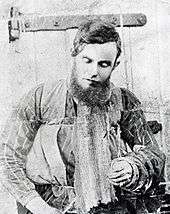



| Name | Lived | Area of activity | Fate |
|---|---|---|---|
| Matthew Brady | 1799–1826 | Van Diemen's Land | Hanged |
| Mary Ann Bugg | 1834–1905 | Northern New South Wales | Died of old age |
| Joe Byrne | 1857–1880 | North East Victoria | Shot by police |
| John Caesar | 1764–1796 | Sydney area | Shot |
| Captain Moonlite | 1842–1880 | New South Wales | Hanged |
| Captain Starlight | 1841–1901 | Queensland | Imprisoned, died a free man |
| Captain Thunderbolt | 1835–1870 | New South Wales | Shot by police |
| Martin Cash | c. 1808–1877 | Van Diemen's Land | Imprisoned, died a free man |
| Clarke brothers | 1840/1846-1867 | New South Wales | Hanged |
| Patrick Daley | 1844–? | New South Wales | Imprisoned, died a free man |
| Edward Davis | ?–1841 | Northern New South Wales | Hanged |
| Jack Donahue | c. 1806–1830 | Sydney area | Shot by police |
| Jack the Rammer | ?–1834 | South Eastern New South Wales | Shot |
| John Dunn | 1846–1866 | Western New South Wales | Hanged |
| John Francis | c. 1825–? | Goldfields region of Victoria | Imprisoned, cause of death unknown |
| Frank Gardiner | c. 1829–c. 1904 | Western New South Wales | Imprisoned, died a free man |
| John Gilbert | 1842–1865 | Western New South Wales | Shot by police |
| Jimmy Governor | 1875–1901 | New South Wales | Hanged |
| Ben Hall | 1837–1865 | Western New South Wales | Shot by police |
| Steve Hart | 1859–1880 | North East Victoria | Possible suicide |
| Michael Howe | 1787–1818 | Van Diemen's Land | Captured and killed |
| Thomas Jeffries | ?–1826 | Van Diemen's Land | Hanged |
| Lawrence Kavenagh | c. 1805–1846 | Van Diemen's Land | Hanged |
| Dan Kelly | c. 1861–1880 | North East Victoria | Possible suicide |
| Ned Kelly | c. 1854–1880 | North East Victoria | Hanged |
| Patrick Kenniff | 1865–1903 | Queensland | Hanged |
| John Kerney | c. 1844–1892 | South Australia | Imprisoned, died a free man |
| John Lynch | 1813–1842 | New South Wales | Hanged |
| Frank McCallum | c. 1823–1857 | Goldfields region of Victoria | Hanged |
| James Alpin McPherson | 1842–1895 | Queensland | Imprisoned, died a free man |
| Moondyne Joe | c. 1828–1900 | Western Australia | Imprisoned numerous times, died a free man |
| Dan Morgan | c. 1830–1865 | New South Wales | Shot by police |
| Musquito | c. 1780–1825 | Van Diemen's Land | Hanged |
| Alexander Pearce | 1790–1824 | Van Diemen's Land | Hanged |
| Sam Poo | ?–1865 | New South Wales | Hanged |
| Harry Power | 1819–1891 | North East Victoria | Imprisoned, died a free man |
| Owen Suffolk | 1829–? | Victoria | Shot in prison |
| John Tennant | 1794–1837 | New South Wales | Hanged |
| John Vane | 1842–1906 | New South Wales | Imprisoned, died a free man |
| William Westwood | 1820–1846 | New South Wales | Hanged |
References
- ↑ Ian Potter Museum collection: Bushrangers, u21museums.unimelb.edu.au. Retrieved on 9 January 2011.
- ↑ Hirst, John Bradley. Freedom on the Fatal Shore. Black Inc., 2008. ISBN 9781863952071, pp. 408–409.
- 1 2 3 4 5 6 7 "BUSHRANGERS OF AUSTRALIA" (PDF). National Museum of Australia. Archived from the original (PDF) on 5 September 2007. Retrieved 2007-04-16.
- ↑ "Bushranger Thunderbolt and Mary Ann Bugg". Accessed 9 October 2011.
- ↑ Baxter, Carol. Captain Thunderbolt and his Lady: the true story of bushrangers Frederick Ward and Mary Ann Bugg. Crows Nest, New South Wales: Allen & Unwin, 2011. ISBN 978-1-74237-287-7
- 1 2 Australian film and television chronology: The 1910s, Australian Screen. Retrieved 8 October 2015.
- ↑ Cooper, Ross; Pike, Andrew. Australian Film, 1900-1977: A Guide to Feature Film Production. Oxford University Press, 1998. ISBN 9780195507843.
- ↑ Reade, Eric (1970) Australian Silent Films: A Pictorial History of Silent Films from 1896 to 1926. Melbourne: Lansdowne Press, 59. See also Routt, William D. More Australian than Aristotelian:The Australian Bushranger Film,1904-1914. Senses of Cinema 18 (January-February), 2002. The banning of bushranger films in NSW is fictionalised in Kathryn Heyman's 2006 novel, Captain Starlight's Apprentice.
- ↑ "Old Windsor Road and Windsor Road Heritage Precincts". Heritage and conservation register. New South Wales Roads and Traffic Authority. Retrieved 2007-04-20.
- ↑ "Robbery Under Arms". Australian Scholarly Editions Centre. Retrieved 2007-04-17.
- ↑ "Rolf Boldrewood". Internet Movie Database.
- ↑ Graulich, Melody; Tatum, Stephen. Reading the Virginian in the New West. Lincoln, Nebraska: University of Nebraska Press, 2003. ISBN 0-8032-7104-2
External links
| Wikimedia Commons has media related to Bushrangers. |
- Bushrangers trail at Picture Australia
- Bushrangers at Australianhistory website
- Bushrangers on the National Museum of Australia website